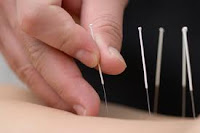There are changes that can be made, however, to retrain the brain. We must consider what things are good (or healthy) for the brain and nervous system, and what things are bad (unhealthy) for the nervous system. Taking a broad view of your individual lifestyle can help narrow down possible triggers and contributors to your pain. From a medical standpoint, medications and ointments can help to a small degree, but they should not be the final solution to a chronic pain problem. In fact, they should be gradually lessened, while broader approaches are increased. The video also points out that while many people may initially consider surgery, it may not be the best option, and second opinions should be sought.

The next area to be considered is the patient’s emotional state. Emotions play a large role in how sensitive the brain is to pain. Thoughts and beliefs create a type of energy in the brain. Have you ever known someone to talk themselves into being sick, or sicker than they actually are? I do, and I’ve even done it myself. It’s often hard to be objective about your thoughts and emotions, but there are actually many steps that can be taken to release stress. Reducing stress can have a substantial effect on relieving pain.
Another area to consider is one that I write about most often – diet and lifestyle. I know this is hard to believe, but the typical Western lifestyle is not a very healthy way to live. The highly processed, pesticide-ridden food we eat, and the sedentary, ultra-connected lifestyle we live, combine to make our neurological systems extra sensitive and therefore increase our pain sensitivity. Activities like smoking, drinking alcohol, eating fast foods (and let’s be honest, MOST American food is really unhealthy) and a lack of exercise should be cut from our lives.
The fourth area that should be considered is the larger picture: your life story. Are there any unresolved issues that need to be dealt with? Also there may be a traumatic life event that might have occurred around the approximate time the pain began. Recognizing and addressing these issues, along with the other steps in the greater pain plan can greatly reduce a person’s pain signals.
 |
| Yoga can provide both physical and mental benefits. |
These steps work together to form the beginning of a pain plan. Get help if you need it, whether through a nutritionist, counselor, acupuncturist, or if you’re incredibly lucky, a great doctor that can guide and help you through the pain plan.
My “pain plan” was not so concise. It was a combination of trial and error, a lot of personal research, and time spent talking to others who had found some relief through trying different approaches. I found a substantial amount of relief when I reduced stressors in my personal life. I began to eat differently, try different combinations of supplements, and to get more sleep, more consistently. I was fortunate to find an acupuncturist who took the time to address a lot of these issues systematically. I highly recommend giving acupuncture a chance, as it helped me tremendously. I had a fear of needles, and even though I was very nervous, I was willing to take the chance and get over, or at least ignore this, as my pain was worse than my paranoia. I remember one session vividly, as I spent basically the entire time in tears. It was a bit weird, but it was definitely a breakthrough moment for me. I’ll try to give you the details in a clear way (It’s really hard to explain what happened logically.) I was lying on my back, with needles in the outside of my left leg. I had been having nerve pain radiating down from my hip and into my thigh. About 20 seconds after my acupuncturist turned out the lights and left the room, my brain started screaming “PAIN!!!! PAIN!!!!! START SCREAMING AND WRITHING BECAUSE YOU’RE IN SO MUCH PAIN!!!” The weird thing? I wasn’t.
 |
| I still cry when I have blood drawn, but acupuncture is a breeze. |
I’m not entirely sure that the pain plan, such as it was, is related to increased happiness, but I can’t deny it either. If happiness is somehow controllable, if it’s somehow attainable for the average American, can following the same steps as the pain plan lead to happiness? I know that correlation does not equal causation, but I can’t ignore the timing.
 WHAT IF changing a person’s diet, increasing exercise, reducing stress, and dealing with emotional issues and past hurts increase that person’s happiness? Is it worth it to you to make these changes in your own life to be happier? I certainly think so!
WHAT IF changing a person’s diet, increasing exercise, reducing stress, and dealing with emotional issues and past hurts increase that person’s happiness? Is it worth it to you to make these changes in your own life to be happier? I certainly think so!

No comments:
Post a Comment